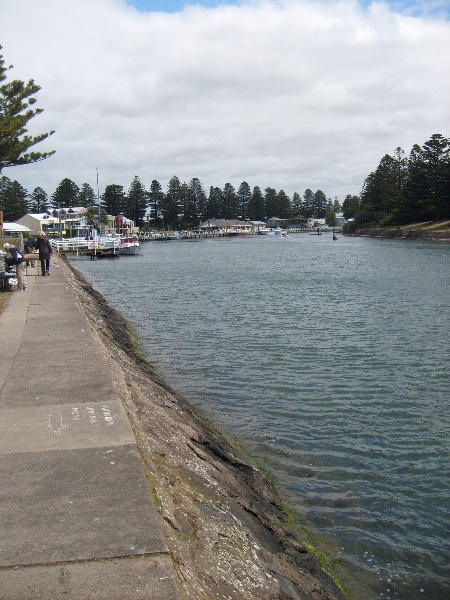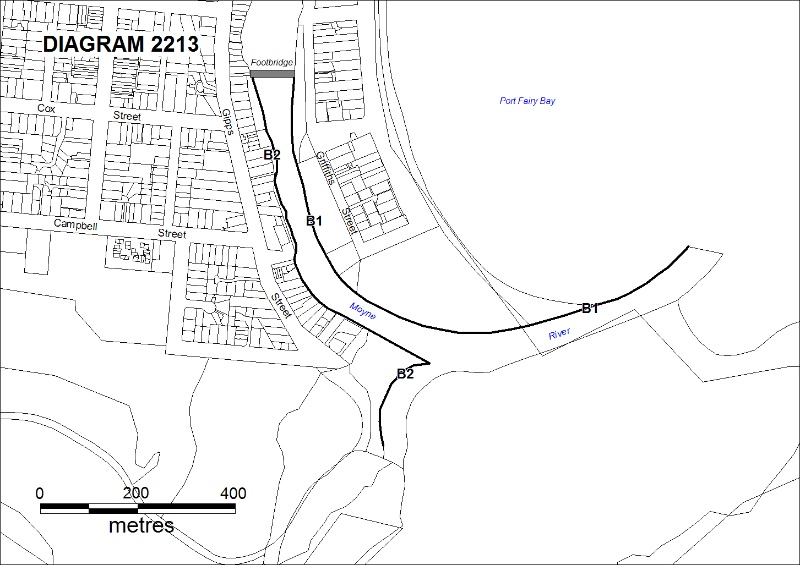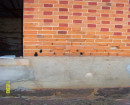MOYNE RIVER TRAINING WALLS
MOYNE RIVER PORT FAIRY, MOYNE SHIRE
-
Add to tour
You must log in to do that.
-
Share
-
Shortlist place
You must log in to do that.
- Download report



Statement of Significance
What is significant?
The Moyne River Training Walls works were undertaken between 1869 and 1874 to make the Moyne River navigable and allow seaborne trade to develop at Port Fairy, in particular to serve demand for shipping wool. A pier and tramway constructed by 1860 to serve shipping in the Bay was a dismal failure, and a railway link was not achieved until 1890, so Port Fairy was dependent on a navigable Moyne River for its growth. River access for coastal vessels was achieved in 1872, and the first vessels Elizabeth and Rambler were towed through the entrance by the paddle steamer tug Surprise.
The Moyne River Training Walls extend from the pedestrian footbridge at Gipps Street on both sides of the river to the moles projecting into Port Fairy Bay and include walls along the South West Passage. Basalt was quarried from sites on Griffiths Island, and the battered basalt walls contain and project the river flow into the bay, making use of coastal wave force from the South West passage to project the suspended river silt through the mouth. The concept was developed by NSW engineer E O Moriarty with later alterations by W H Steel, Inspector-General, Public Works Department, British harbour engineer Sir John Coode, and E M De Burgh, Chief Engineer for Harbours, NSW. However, the self-flushing action created navigational problems, and the South West passage was sealed off from the river in 1911. Since then regular dredging of the Moyne River has been required in order to maintain navigability.
While the walls permit access from the sea into the river, the structures have led to a significant alteration of the landscape from coastal erosion and sand accumulation, significantly altering the form of Griffiths Island, a sand dune over a basaltic intrusion that protects the entrance of the Moyne River to the sea.
How is it significant?
The Moyne River Training Walls are of historical and scientific (technical) significance to the State of Victoria.
Why is it significant?
The Moyne River Training Walls are historically significant as evidence of Victoria's nineteenth century investment in regional port infrastructure. They are significant for their historical importance to the port of Port Fairy, and the development of Victorian coastal shipping. After efforts to build a pier in the bay were totally disappointed, the opening of the river by the use of the walls to project and contain the river's flow allowed the town to develop as a port that provided important regional trade links until the Second World War.
The Moyne River Training Walls are of scientific (technical) significance as a civil engineering project which sought to use the power of the sea to provide impetus to the river to carry suspended sediment into the bay, beyond the mouth of the river. It is a physical representation of the confidence apparent in a number of nineteenth century plans which assumed that natural forces could be overcome or contained by engineering. It is a rare example of such works surviving in unmodified form, as other Victorian works have been substantially modified to meet commercial requirements.-
-
MOYNE RIVER TRAINING WALLS - Assessment Against Criteria
Assessment against criteria
MOYNE RIVER TRAINING WALLS - Plaque Citation
Progressively developed over several decades from1869 to facilitate river access for seaborne trade, the walls are historically significant as an example of Victoria's nineteenth century investment in regional port infrastructure.
MOYNE RIVER TRAINING WALLS - Permit Exemptions
General Exemptions:General exemptions apply to all places and objects included in the Victorian Heritage Register (VHR). General exemptions have been designed to allow everyday activities, maintenance and changes to your property, which don’t harm its cultural heritage significance, to proceed without the need to obtain approvals under the Heritage Act 2017.Places of worship: In some circumstances, you can alter a place of worship to accommodate religious practices without a permit, but you must notify the Executive Director of Heritage Victoria before you start the works or activities at least 20 business days before the works or activities are to commence.Subdivision/consolidation: Permit exemptions exist for some subdivisions and consolidations. If the subdivision or consolidation is in accordance with a planning permit granted under Part 4 of the Planning and Environment Act 1987 and the application for the planning permit was referred to the Executive Director of Heritage Victoria as a determining referral authority, a permit is not required.Specific exemptions may also apply to your registered place or object. If applicable, these are listed below. Specific exemptions are tailored to the conservation and management needs of an individual registered place or object and set out works and activities that are exempt from the requirements of a permit. Specific exemptions prevail if they conflict with general exemptions. Find out more about heritage permit exemptions here.Specific Exemptions:Regular Site Maintenance:
The following site maintenance works are permit exempt under section 66 of the Heritage Act 1995:
a) Stabilising and rebuilding of the walls is permitted provided bluestone pitchers are individually numbered and rebuilt to the same arrangement.
b) Port of Port Fairy related operations activities such as training wall repairs, road access, works on navigational aids and regular site maintenance such as lighting repairs provided the works do not involve the removal or destruction of any significant above-ground features or sub-surface archaeological artefacts or deposits;
c) the maintenance of an item to retain its conditions or operation without the removal of or damage to the existing fabric or the introduction of new materials;
d) cleaning including the removal of surface deposits, organic growths, or graffiti by the use of low pressure water and natural detergents and mild brushing and scrubbing;
e) repairs, conservation and maintenance to plaques, memorials, roads and paths, fences and gates and drainage and irrigation:
f) the replacement of existing services such as cabling, plumbing, wiring and fire services that uses existing routes, conduits or voids, and does not involve damage to or the removal of significant fabric.
g) Coprosma seedlings growing in the gaps in pointing should be removed
Note: Surface patina which has developed on the fabric may be an important part of the item's significance and if so needs to be preserved during maintenance and cleaning.
Note: Any new materials used for repair must not exacerbate the decay of existing fabric due to chemical incompatibility, obscure existing fabric or limit access to existing fabric for future maintenance. Repair must maximise protection and retention of fabric and include the conservation of existing details or elements.
Public Safety and Security:
The following public safety and security activities are permit exempt under section 66 of the Heritage Act 1995:
a) public safety and security activities provided the works do not involve the removal or destruction of any significant above-ground structures or sub-surface archaeological artefacts or deposits;
b) the erection of temporary security fencing, scaffolding, hoardings or surveillance systems to prevent unauthorised access or secure public safety which will not adversely affect significant fabric of the place including archaeological features;
c) development including emergency stabilisation necessary to secure safety where a site feature has been irreparably damaged or destabilised and represents a safety risk to its users or the public.
Note: Urgent or emergency site works are to be undertaken by an appropriately qualified specialist such as a structural engineer, in consultation with a heritage professional. General Conditions: 1. All exempted alterations are to be planned and carried out in a manner which prevents damage to the fabric of the registered place or object. General Conditions: 2. Should it become apparent during further inspection or the carrying out of works that original or previously hidden or inaccessible details of the place or object are revealed which relate to the significance of the place or object, then the exemption covering such works shall cease and Heritage Victoria shall be notified as soon as possible. Note: All archaeological places have the potential to contain significant sub-surface artefacts and other remains. In most cases it will be necessary to obtain approval from the Executive Director, Heritage Victoria before the undertaking any works that have a significant sub-surface component. General Conditions: 3. If there is a conservation policy and plan endorsed by the Executive Director, all works shall be in accordance with it. Note: The existence of a Conservation Management Plan or a Heritage Action Plan endorsed by the Executive Director, Heritage Victoria provides guidance for the management of the heritage values associated with the site. It may not be necessary to obtain a heritage permit for certain works specified in the management plan. General Conditions: 4. Nothing in this determination prevents the Executive Director from amending or rescinding all or any of the permit exemptions. General Conditions: 5. Nothing in this determination exempts owners or their agents from the responsibility to seek relevant planning or building permits from the responsible authorities where applicable. Signage and Site Interpretation : The following Signage and Site Interpretation activities are permit exempt under section 66 of the Heritage Act 1995, a) signage and site interpretation activities provided the works do not involve the removal or destruction of any significant above-ground structures or sub-surface archaeological artefacts or deposits; b) the erection of signage for the purpose of ensuring public safety or to assist in the interpretation of the heritage significance of the place or object and which will not adversely affect significant fabric including landscape or archaeological features of the place or obstruct significant views of and from heritage values or items; c) signage and site interpretation products must be located and be of a suitable size so as not to obscure or damage significant fabric of the place; d) signage and site interpretation products must be able to be later removed without causing damage to the significant fabric of the place; Note: The development of signage and site interpretation products must be consistent in the use of format, text, logos, themes and other display materials. Note: Where possible, the signage and interpretation material should be consistent with other schemes developed on similar or associated sites. It may be necessary to consult with land managers and other stakeholders concerning existing schemes and strategies for signage and site interpretation. Minor Works : Note: Any Minor Works that in the opinion of the Executive Director will not adversely affect the heritage significance of the place may be exempt from the permit requirements of the Heritage Act. A person proposing to undertake minor works may submit a proposal to the Executive Director. If the Executive Director is satisfied that the proposed works will not adversely affect the heritage values of the site, the applicant may be exempted from the requirement to obtain a heritage permit. If an applicant is uncertain whether a heritage permit is required, it is recommended that the permits co-ordinator be contacted.MOYNE RIVER TRAINING WALLS - Permit Exemption Policy
The purpose of the permit exemptions is to allow management works that does not impact on the significant heritage values.
-
-
-
-
-
EMOH
 Victorian Heritage Register H0252
Victorian Heritage Register H0252 -
GUNS AND EMPLACEMENTS
 Victorian Heritage Register H1504
Victorian Heritage Register H1504 -
PORT FAIRY COURT HOUSE
 Victorian Heritage Register H1480
Victorian Heritage Register H1480
-
'The Pines' Scout Camp
 Hobsons Bay City
Hobsons Bay City -
106 Nicholson Street
 Yarra City
Yarra City -
12 Gore Street
 Yarra City
Yarra City
-
-












